Let's consider how mastering the art of deploying and stowing a trolling motor can elevate our boating experience to a new level of ease and efficiency. We all know the frustration of wrestling with a motor that refuses to cooperate when we're keen to hit the water. By honing our technique, not only do we enhance safety and prevent unnecessary wear, but we also manage our time on the water more effectively. But what steps should we actually take to simplify this process while ensuring reliability every time? There's more to uncover about perfecting this vital aspect of boating.
Choosing the Right Trolling Motor
Choosing the right trolling motor can make all the difference when it comes to enhancing your boating experience. Let's face it—nothing beats the sensation of freedom that comes with smoothly traversing vast waters.
That's why understanding thrust calculation and battery selection is essential. First, calculating the proper thrust for your motor is vital, as it gives our boat the power needed to handle different conditions. Larger, heavier boats and tough weather demand higher thrust, ensuring we won't get stuck when the going gets rough. Thrust is about pull and twist, similar to torque in cars, not top-end speed, so it is crucial for maintaining maneuverability and control in challenging environments.
Now, let's talk batteries. Proper battery selection is crucial for powering our motor efficiently and for long periods. With options like 12V, 24V, and 36V, we can tailor our setup based on the boat's needs while also considering the best configuration for balancing performance and runtime.
Remember, a well-matched battery system keeps the motor running smoothly and prolongs its life.
Combining the right thrust with an ideal battery setup helps us enjoy longer, carefree days on the water without constantly worrying about power draining too fast. Together, they form the backbone of a boating experience that's both powerful and liberating.
Preparing for Motor Deployment
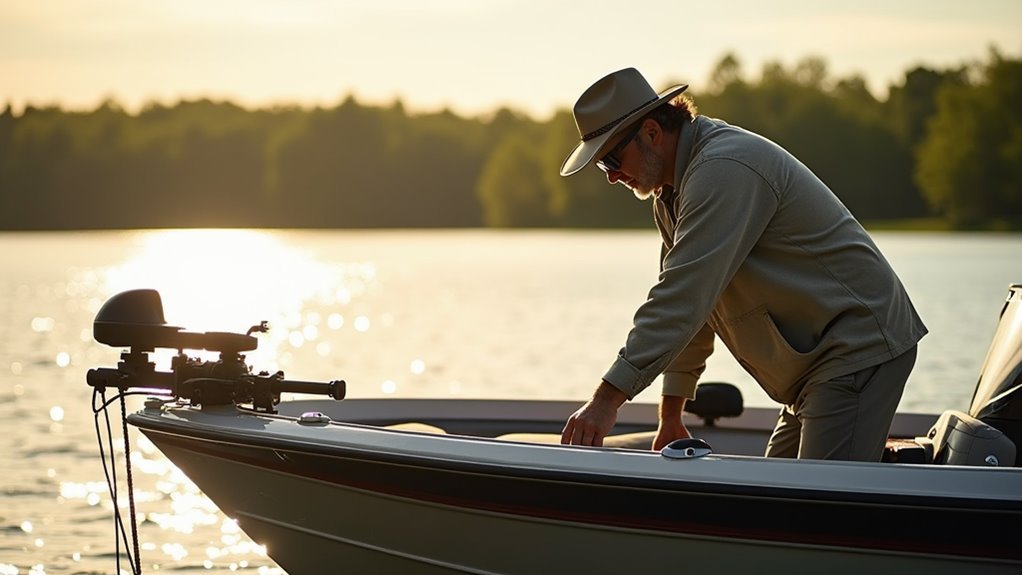
Understanding the fundamentals of thrust and battery selection sets the stage for our next task: preparing for motor deployment. We've got the right tools, and now it's all about getting everything ready for that first adventure with our trolling motor.
First, let's talk about deck alignment. We need to secure our motor in its operating position to decide where the mounting pad will sit on the deck. This is vital because it guarantees stability and ease of use when we're out on the water.
Next, we've got to address shaft clearance. It's important to identify any areas where the shaft might interfere with the bow rail. By securely placing the motor in a quick-release pad, we can see exactly where the shaft will pass through. Regular inspection of the propeller and drive system is crucial to ensure there is no debris, weeds, or fishing line that could hinder performance or cause damage.
Sometimes, if the deck is angled, we might need to fabricate a mounting plate to keep everything aligned. Don't forget to measure and mark the bow rail for any sections that need to be cut out to avoid interference.
Lastly, before deployment, double-check that cables are neatly secured and free from damage. Remember to clean and inspect the prop, and guarantee tight battery connections for peak performance.
Step-by-Step Deployment Process
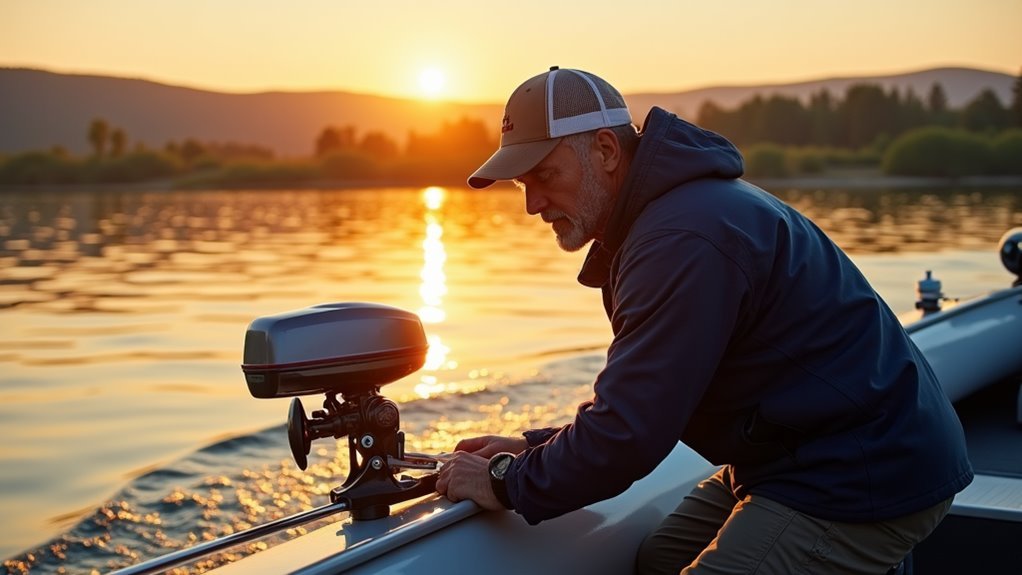
To kick off the deployment of our trolling motor, we'll focus on optimizing both efficiency and accuracy. First, let's talk about some handy deployment tricks.
For the Ulterra trolling motor, avoid accidental deployment by quickly pressing the deploy button twice. Whether we're using the remote or the foot pedal, this simple trick guarantees freedom and control over when our motor hits the water.
We can initiate remote deployment by double-tapping the deploy button, while on the foot pedal, this is done by pressing the mode button followed by the middle button twice. It's crucial to ensure the remote is in the correct mode prior to initiating deployment; this simple check can prevent unnecessary hiccups.
With Ulterra QUEST, find the deploy option in the menu by pressing the One Boat Network button on the remote and using the right arrow to select "Deploy."
Motor calibration is vital, so we confirm everything is in working order once the motor slowly extends into the water. This guarantees our motor responds perfectly during use.
We should always check our foot pedal is in Ulterra mode, indicated by a yellow light, before deployment. This guarantees our adventures on the water begin smoothly, giving us the freedom to explore with confidence and ease.
Let's get out there and enjoy the open water.
Common Deployment Mistakes
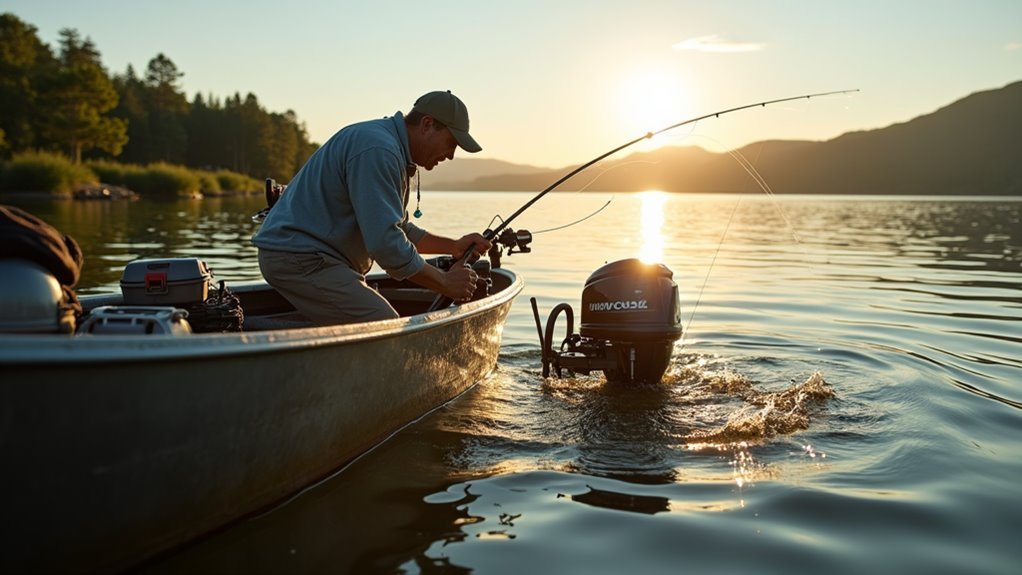
Deploying a trolling motor might seem straightforward, but common mistakes can trip up even seasoned boaters. It's important to understand both User Misinterpretation and the Environmental Factors that can influence successful deployment.
Let's delve into some frequent pitfalls to keep things smooth.
1. User Misinterpretation: Many errors come from misunderstanding controls. Missteps can occur when we don't realize a double press is needed to deploy a motor or when forgetting the foot pedal should be set to Ulterra mode. Fully grasping the button functions prevents accidental settings.
2. Environmental Factors: Nature can affect deployment too. Wind or current strength might make us think we need to push or assist the motor manually, which often signals hidden problems.
Also, external debris around the motor can stop it from deploying correctly. Regular maintenance can prevent many common issues by addressing potential obstructions and keeping equipment in optimal condition.
3. Connection and Power Issues: Ensuring our batteries aren't weak and that all electrical connections are intact prevents voltage drops that lead to deployment failure. Pay attention to corrosion, as it wears plugs and connections.
Considering these factors, along with regular checks and proper maintenance, helps us enjoy hassle-free boating adventures.
Let's set sail with the confidence that we've taken care of our trolling motor right from the start.
Efficient Motor Stowing Guide
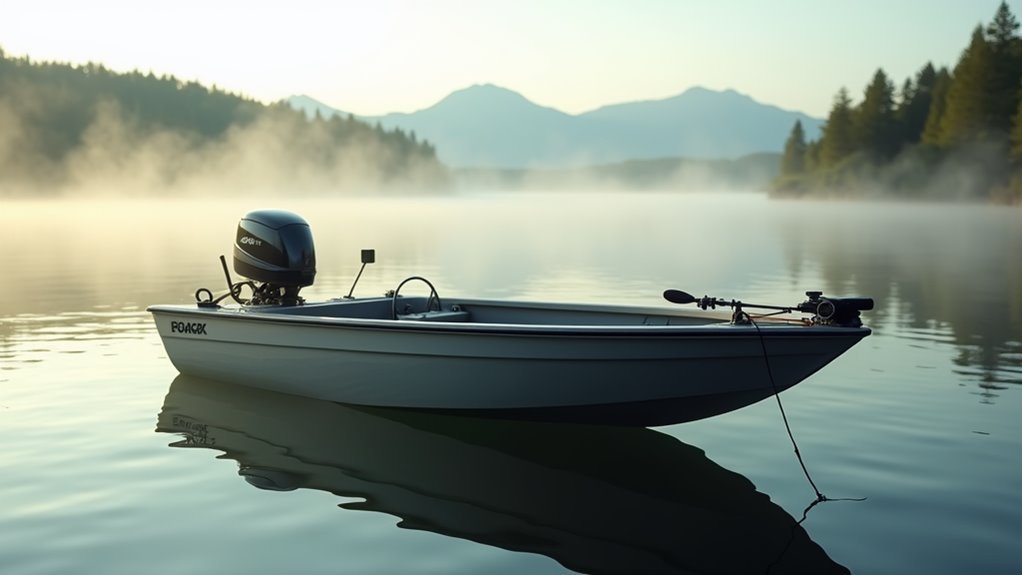
Now that we've navigated the common pitfalls of motor deployment, let's explore how to efficiently stow our trolling motors, ensuring they're ready for the next adventure. Efficient stowing can be tricky, but we can overcome these stowing challenges with the right techniques.
First, if we're using the foot pedal method, make sure it's set to Ulterra control mode, then press the mode button until the yellow LED lights up. A single press on the middle button takes care of the rest as the motor stows automatically. This method reduces the risk of accidental deployment, keeping us on track for future outings.
For those of us handling the AI Pilot Link Remote, remember to have the motor fully deployed before stowing. Using the up or down arrow keys, we can easily manage this process with minimal hassle. To ensure smooth operation, the remote method offers convenience and is preferred by users who enjoy distance control over their equipment.
When manual stowing comes into play, precision is key. We need to manually tilt the motor until the alignment tabs and powerhead meet the base precisely. A Phillips screwdriver can be handy here—just remember, motor alignment must be spot on to avoid damage.
Ensuring the boat is stopped and power is off will keep things safe and straightforward.
Troubleshooting Stowing Issues
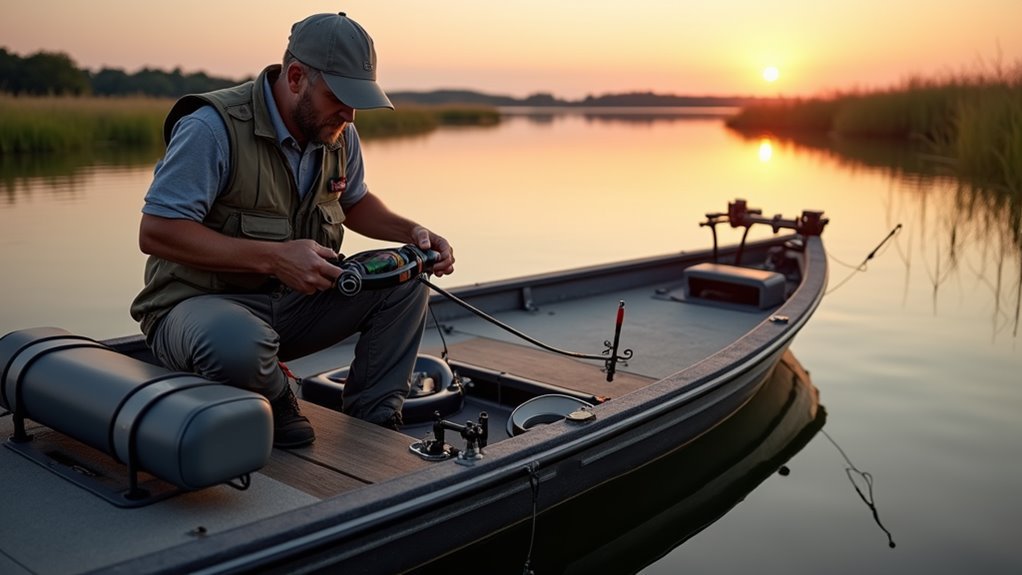
Encountering issues with stowing our trolling motors can certainly be frustrating, but with a systematic approach, we can address these challenges effectively. Stowing diagnostics help us identify common culprits quickly.
A primary step is verifying our batteries are fully charged and connections corrosion-free, as these can often cause stowing malfunctions.
Next, let's tackle mechanical obstructions. A blocked stowing path or tangled fishing line around the motor shaft can thwart our plans for a smooth retreat. Carrying out a visual inspection before heading out can save us a headache later. On occasion, recalibration may be necessary to ensure that the motor returns to its factory alignment and operates smoothly.
In addition, these steps should be followed:
- Use silicone lubricant on the stowing components to guarantee parts glide effortlessly.
- Inspect for debris and clear any obstructions from the stowing path.
- Clean the sensor and spring, verifying the mechanism is free-moving and well-lubricated.
Finally, realigning the motor with a simple reset can guarantee it trims correctly. By cycling the power and recalibrating, we can return our motors to their ideal alignment.
Essential Safety Precautions
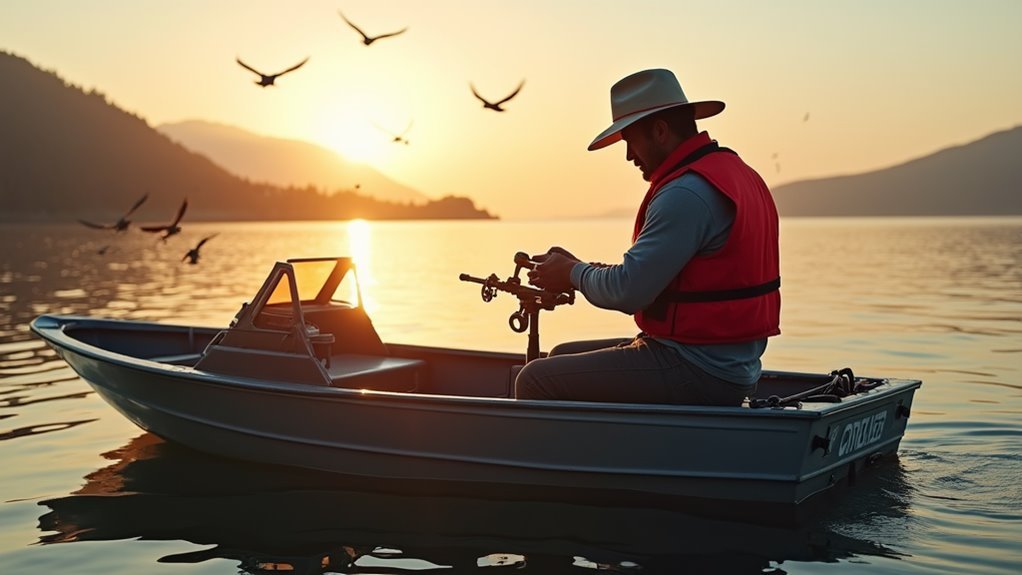
When it comes to using trolling motors, safety above all should be our primary concern. First, we need to give our equipment a thorough pre-deployment safety check. Inspecting the propeller for debris like fishing lines or aquatic plants is vital as these can damage the motor. Make sure the motor's secured in place—this prevents unfortunate accidents during adjustments. We should also familiarize ourselves with local laws and guarantee our battery and connections meet Coast Guard standards.
While on the water, let's remember some essential operational safety precautions. It's important to stop the motor if anyone is near the boat in the water and never operate it in strong currents or winds that exceed its thrust. Regularly checking and cleaning the trolling motor propeller for debris not only ensures safety but also promotes the overall efficiency of the trolling motor. Being aware of water hazards and having emergency protocols at the ready guarantees we're prepared for any situation.
Lastly, make sure everyone on board knows how to operate the trolling motor safely. Recognizing changing water conditions and observing safety etiquette form part of our shared responsibility. Reading and following the manufacturer's guidelines can prevent mishaps and keep our adventures smooth. With these steps, we'll enjoy the freedom of the water with safety as our steadfast companion.
Maintenance Tips for Longevity
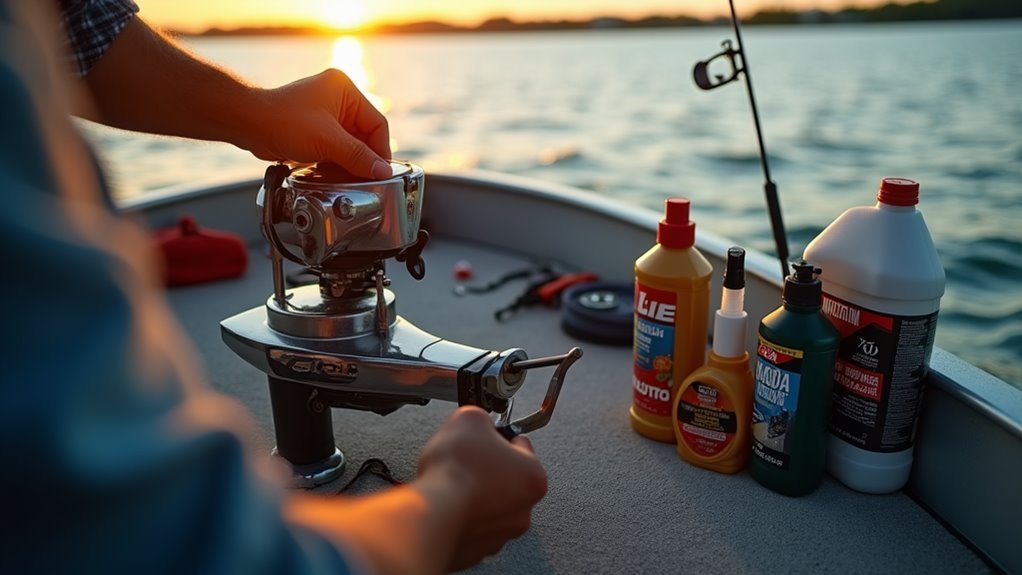
To keep our trolling motors running smoothly and extend their lifespan, diligent maintenance is crucial. It's essential that we care for both battery health and motor durability.
By focusing on the following steps, we can enjoy more time on the water without unexpected hiccups.
- Monitor Battery Cycles: Consistently charging our batteries fully after each use prevents nasty lead sulfate buildup. Using a battery monitor helps track these cycles, allowing us to estimate battery longevity. Remember, lithium batteries could last over 10 years with up to 15,000 cycles if treated right!
- Inspect Motors Regularly: We must look over our motors for any signs of wear or damage often. Check the propeller and shaft for issues—keeping these parts in good shape guarantees smooth operation. Don't overlook the motor housing and control head, as they help fend off electrical problems and overheats.
- Adapt to Environmental Factors: The place where we mount our motor affects its life. Transom-mounted motors get less wave action, lasting 3-5 years, while bow-mounted ones, if cared for, endure 5-7 years. Additionally, frequent cleaning is vital for motors used in saltwater, as it can cut the lifespan to 2-4 years due to corrosion.
Let's commit to these practices and embrace the freedom of hassle-free, long-lasting adventures on the water.
Tools to Simplify the Process
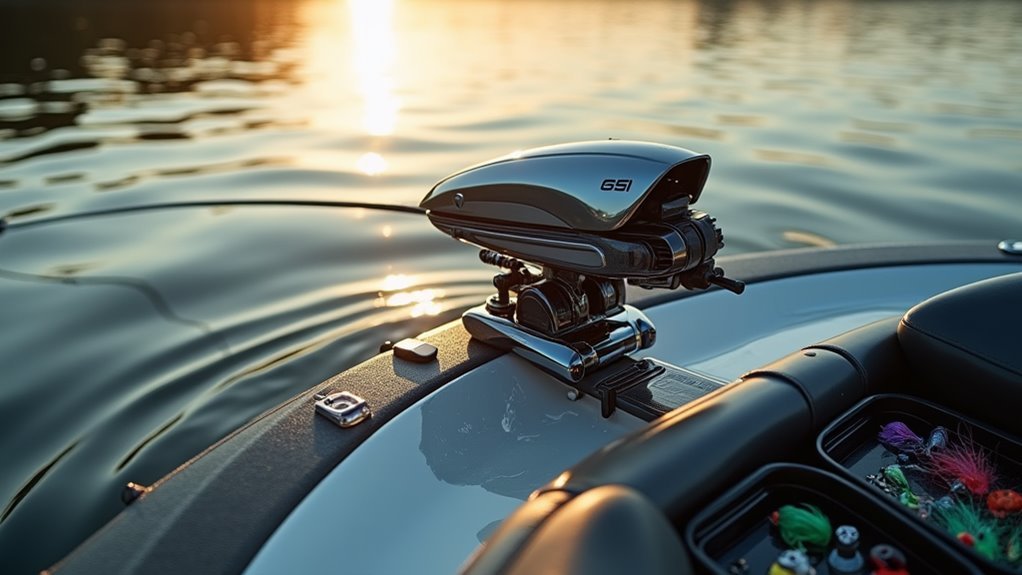
Having guaranteed our trolling motors are well-maintained and ready for action, let's explore ways to simplify their use on the water. We all enjoy the feel of freedom on the open waves, and with the right tools, easing the deployment and stowage of our trolling motors can make our experience even smoother.
Swivel Brackets like the Sea Swivel Trolling Motor Bracket are fantastic additions for our adventure. With its heavy-duty design and CNC precision, it allows our motor mounts to adjust flawlessly, making deployment and shaft clearance a breeze. The single bolt mounting system significantly reduces installation time, making it easier to ready our boats for the water.
Its durable construction means we won't have to worry about replacements any time soon, giving us peace of mind.
For those who love a hands-on approach, creating a DIY rope-based deployment system might be the ticket. It's a simple yet effective two-step process that guarantees safety and control while launching or retracting the motor.
By strategically placing ropes and rings, we customize this setup to fit our unique boating needs.
Remote and foot pedal controls like those with Minn Kota Ulterra offer another layer of convenience. We're no longer restricted to manual adjustments, allowing us to focus more on the journey ahead.
Enhancing Your Boating Experience
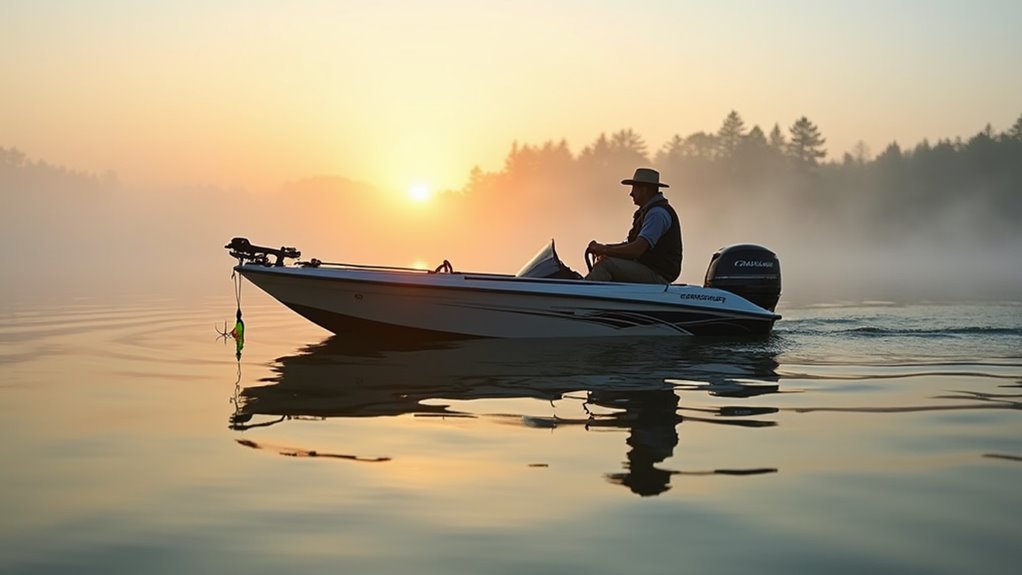
Enhancing our boating experience starts with mastering the deployment and use of our trolling motors. We've all felt the thrill of freedom that comes with gliding smoothly across the water, and having the right tools makes it even better.
Boat ergonomics play a big role in ensuring a comfortable journey, allowing us to focus more on the adventure and less on the mechanics. Thankfully, the Minn Kota Ulterra leads the way with its automatic stow/deploy features, making boating more enjoyable and less of a hassle. Its versatile usage means it is ideal for anglers of all ages, providing an easier experience especially beneficial in rough water conditions.
Let's look at how we can enhance our time out on the water:
- Utilize Advanced Control Systems: The integration with the one boat Network allows for seamless control, simplifying operations and enhancing our overall experience.
- Prioritize Regular Maintenance: Keeping everything in check extends our motor's life and keeps performance ideal, ensuring every outing is as good as the last.
- Embrace User Feedback: Listening to others' experiences and insights can offer fresh perspectives and solutions for our own challenges.
Frequently Asked Questions
How Does Weather Affect Trolling Motor Performance?
Weather impacts trolling motor performance. We encounter wind resistance affecting control and water clarity influencing visibility, adjusting speed and direction to stay free-spirited on open waters, always adapting to natural elements for our journey.
Can Trolling Motors Be Used in Saltwater Environments?
Yes, we can use trolling motors in saltwater environments. They're designed to resist saltwater corrosion and minimize marine life interference. Just maintain them properly, so we're free to explore the open sea without worries.
What Are the Best Battery Types for Trolling Motors?
We'd recommend lithium batteries for trolling motors due to their longer lifespan and efficient charging methods. They're lightweight and provide consistent power, offering us the freedom to explore without worrying about frequent battery changes or downtime.
How Do Underwater Obstacles Impact Motor Deployment?
Picture ourselves traversing a maze; underwater obstacles are the walls. They challenge motor deployment, demanding careful obstacle avoidance and depth adjustment. Freedom on water requires awareness and quick adjustments to keep our boating journey smooth and uninterrupted.
Can Multiple Trolling Motors Be Used Simultaneously on a Large Boat?
We can use multiple trolling motors simultaneously on a large boat, but we'll face challenges with motor synchronization and power distribution. By optimizing these systems, we'll maintain control and enjoy greater freedom on the water.
Conclusion
So, let's reel it in! Mastering trolling motor deployment and stowing isn't exactly high drama, but it's no less important. Picture us as boating ninjas, deftly deploying motors with precision that would make even a circus acrobat nod in approval. We're conquering waves, dodging debris, and securing our ride with ease. Our boats will zoom so smoothly, fish won't stand a chance! Stick to our tips, keep safety in mind, and let's ride those waters with style!